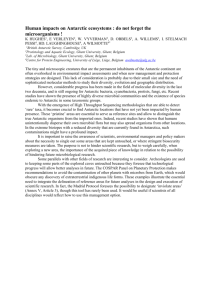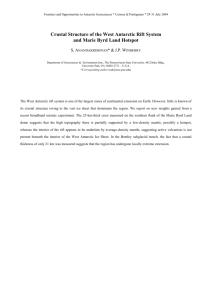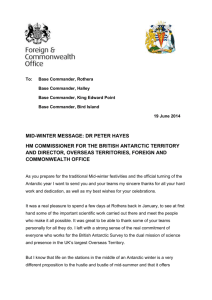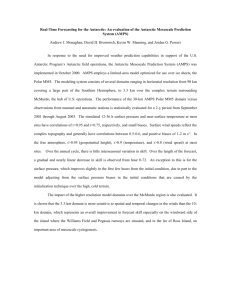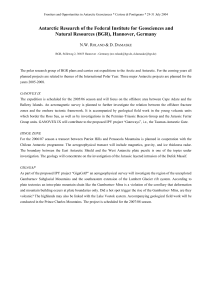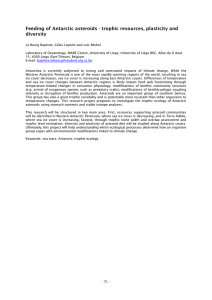REMOTE SENSING CARTOGRAPHY IN ANTARCTIC ... H. Schmidt-Falkenberg Institut fUr Angewandte Frankfurt a.M.
advertisement
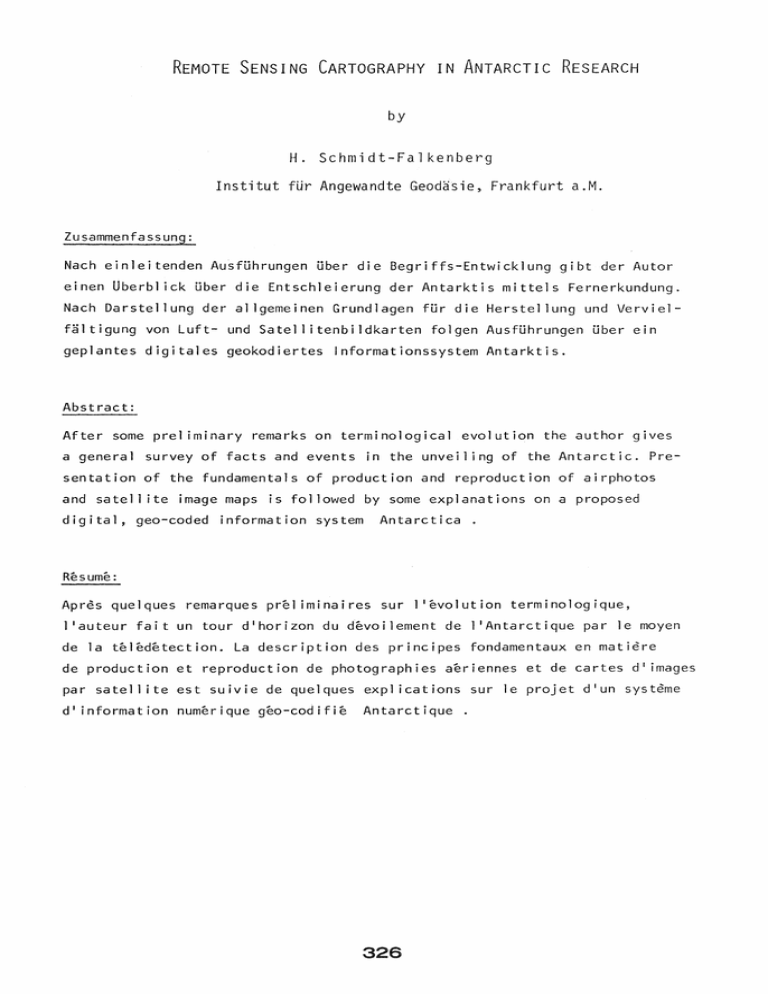
REMOTE SENSING CARTOGRAPHY IN ANTARCTIC RESEARCH
by
H. Schmidt-Falkenberg
Institut fUr Angewandte
Geod~sie,
Frankfurt a.M.
Zusammenfassung:
Nach einleitenden Ausfuhrungen uber die Begriffs-Entwicklung gibt der Autor
einen Uberbl ick uber die Entschleierung der Antarktis mittels Fernerkundung.
Nach Darstel1ung der al1gemeinen Grundlagen fur die Herstel lung und Vervielfaltigung von Luft- und Satel 1 itenbildkarten folgen Ausfuhrungen uber ein
geplantes digitales geokodiertes Informationssystem Antarktis.
Abstract:
After some prel iminary remarks on terminological evolution the author gives
a general survey of facts and events in the unveil ing of the Antarctic. Presentation of the fundamentals of production and reproduction of airphotos
and sate11 ite image maps is fo11owed by some explanations on a proposed
digital, geo-coded information system
Antarctica.
Resume:
Apres quelques remarques pre1 iminaires sur 1 'evolution terminologique,
1 'auteur fait un tour d'horizon du devoilement de l'Antarctique par le moyen
de la teledetection. La description des principes fondamentaux en matiere
de production et reproduction de photographies aeriennes et de cartes d ' images
par sate11 ite est suivie de quelques expl ications sur Ie projet d'un systeme
d' information numerique geo-codifie
Antarctique.
326
1. Definitions
Photogramrnetry and remote sensing are extremely young sciences in
comparison with cartography. The oldest cartographic representation
known to us dates back to around 3,800 B.C., and we may assume that
the need of man to represent distances and directions, coastlines,
the position of settlements, towns,rivers, roads, mountains, etc.,
i.e. the means of orientation in a region
on the earth or in the
sky using maps dates back to much earlier than that.
So earth and sky were represented cartographically several thousand
years ago and indeed today they are still the most important objects of cartographic representation, although today data from
different sciences is represented cartographically, e.g. biological
data, such as the map of a human brain.
Cartographic terminology Doday has replaced the terms earth and sky
with planet and space and differentiates accordingly between planetary maps and spatial maps. In addition to cartographic representations of the earth we now have maps of other planets, such as the
Earth's moon, Mars, Venus, etc. The "world's horizon", the largest
distance measured between another planet and the earth, now extends
over approximately 14 thousand million light years, a distance
which we can barely imagine. But cartography is not the only science
affected by these terminological extensions and the advance of
measuring techniques in spatial terms, the development of space
programmes has also benefited. Of course, the task of cartography
327
must be restricted to defining the basic principles of graphic
representation or depiction of the results obtained from observation or research in the special branches of science (such as
topography, geography, geology, etc.). However, the methods of
gleaning this information on the object of representation have,
it has been shown, directly influenced map design, production, reproduction and utilization. It can be said in principle that with
the first aerial photograph
taken from the air (1858) the terms
aerial photography and aerial cartography began to evolve, and
with the first satellite imagery from space (almost exactly 100
years later, in 1959) the terms satellite photomap and satellite
image cartography emerged. The original type of cartography, which
is no less important, is often described with the terms linear
maps and linear cartography.
The definitive characteristics in gathering information on objects
via aerial and satellite photography are twofold: the distance
between object and image recording system is often very large and
there is no direct contact. Force fields, in particular the electromagnetic field, transfer the information. Since we can now use
not only the spectral range visible to us, from about 0.4
0.7
~m,
~m
-
but also other spectral areas of the electromagnetic wave
spectrum, the term photogrammetry emerged around 1866 and the term
remote sensing came into use around 1972. Analogously to the cartographic terms mentioned above, the term remote sensing cartography
ultimately came into being (see fig.
2.
1).
The Unveiling of the Antarctic via Remote Sensing
The first explorers to observe areas of the Antarctic from the air
were Robert Falcon Scott, from Britain, and Erich v. Drygalski,
from Germany.
Both had started on separate Antarctic
expeditions in 1901 and both had a captive balloon in their equipment. Scott conducted his balloon ascent on 4 February 1902 near
328
Whale Bay on the Ross Shelf Ice front and v. Drygalski on
29 March 1902 near Gaussberg mountain. Von Drygalski and some
colleagues reached a height of 500.m in the balloon, when Captain
H. Ruser and the geologist E. Philippi took photographs from that
height of the surrounding area. It has not yet been ascertained
whether Scott also took photographs during his ascent. Table 1
shows the use of aerial reconnaissance and photogrammetry in Antarctic research up to 1945.
Fig. 2
shows which areas of the
Antarctic were covered in this fashion.
World War II drastically reduced the amount of research in the
Antarctic. The military activities of several German auxiliary
cruisers in the Antarctic sea in 1940/41 added to the assumption
that German military bases existed in the Antarctic and resulted
in British and Australian naval operations, with an inevitable reduction in research. The achievements up to 1945 of geographic
reconnaissance and surveying of the Antarctic were considerable,
but large-scale, systematic research into the Antarctic did not
begin until after World War II with the U.S. Expedition "Operation
Highjumpll in the austral
summer of 1946/47. The expedition con-
sisted of 13 ships, 13 planes and over 4.000 men. On the photogrammetric aerial survey flights aerial photographs were taken
covering an area of c. 3.9 million km 2 .
The following countries joined in further topographic investigation
and surveying of the Antarctic: Australia, Belgium, France, Great
Britain, Japan, Norway, Sweden, U.S.A. and U.S.S.R.
The first photographic record of the earth from a space ship, the
first satellite photograph, was taken in 1959, but it was not until
1965 that the first special, extensive programme of photographic
coverage began with the U.s. GEMINI space programme. Approximately
1000 photographs were taken of the earth at a height of aoout 300 km.
329
The LANDSAT space programme began in 1972, and the MSS image data
with a pixel size on the ground of 80 m x 80 m aroused the interest
of people engaged in Antarctic research. The first satellite photo
maps were produced in the USA in 1973 at the 1 : 1,000,000,
1 : 500,000 and 1 : 250,000 scales, followed by further maps in
Great Britain, Australia, the Federal Republic of Germany and
Japan. A further aid to map production were the AVHRR image data
from the NOAA space programme with a pixel size on the ground of
approximately 1 km x 1 km, and from 1982 onwards the additional
TM image data obtained from the LANDSAT space programme with a
pixel size on the ground of 30 x 30 m. HRV image data from the
SPOT space programme have been available since 1986. These have
the largest resolution in satellite imagery at present, with a
pixel size on the ground of 10m x 10 m in the spectrum range
0.5
~m
- 0.9
~m.\
The sensors of the above-mentioned space program-
mes are passive systems and record so-called optical and - in part thermal image data. Of the active systems for registering radar
image data, the space programmes SIR and ESA-ERS are the most interesting for Antarctic research. SIR-B and SIR-C w,ill be put into
a polar orbit, however, the date of the launch is at present unclear. The European satellite ERS-1 will probably be launched in
1991 and will be equipped with an SAR with a pixel size on the
ground of approx. 30 x 30 m. Since the sensors mentioned above
receive large data stocks, normally real-time reception is required (hence there will be no data storage on board). Therefore,
an image data reception station is needed in the Antarctic, if
radar image data have to be recorded also locally. This is, without
doubt, the goal of many geoscientists who are active in Antarctic
research.
330
3.
General Principles of Production and Duplication of
Aerial PhotomaDs
and Satellite Image Maps
It is a well-known fact that photogrammetry and remote sensing deal
with the reproduction of analog and digital image recordings.
Processing and evaluation of these image recordings depends
on the aim-g::.: of the individual project. The aim is often a rapid
flow of data, from recording through processing and evaluation to
output; at times a link with other data stocks may be of value.
Fig.
4.
3
shows such a data flow system.
Digital Geo-Coded Information System Antarctica
All geoscientific research is normally connected to the topography
of the particular reqion of the earth under investigation. Hence,
topographic maps
(produced from aerial photographs or from satel-
lite imagery) are initially the basis for orientation in the terrain
and delimitation of research areas, pOints of survey, etc. Furthermore, they are a necessary basis for representing the results of
geoscientific survey and research in spatial reference to each
other, i.e. in thematic maps based on topographic maps.
Repeated areal surveys of a region can be used to extract information on changes in the landscape, such as ice-caps over sea and
land, ice flow processes, e.g. the kinematics of shelf ice fronts,
etc.
Of the total ice mass on earth, about 9 % is in Greenland, but
90 % in the Antarctic! The maximum thickness of the ice in the
Antarctic is over 4,000 m(near the Russian station Vostock). If
the ice in the Antarctic melted due to some change in the climate,
sea level would rise by about 55 m.
331
If we look back on the emergence of this continent, we find that
initially there was no ice crust, since coal deposits have been
found in the Antarctic, about 250 million ,years old. At that time
the continent was probably covered by dense forests of tree-high
ferns and horsetails. Over the following millions of years these
forests were covered by sediments and were gradually converted
into coal.
Without doubt our global climate is influenced by the conditions
prevailing in the polar regions, particularly by the behaviour of
the inland ice and the shelf ice of the Antarctic.
The Filchner-Ronne Shelf Ice (approx. 500,000 km 2 with flow speeds
of up to 3 m per Bay) together with the adjoining areas to this
shelf ice and the Weddell Sea seawards are therefore important
research projects of the Federal Republic of Germany, and for this
reason are work projects of the Institut fUr Angewandte Geod~sie
in Frankfurt a. M. (IfAG) for the application of photograrnmetry
and remote sensing.
A very real advantage is when the topographic and thematic map data
are available in digital form. Using corresponding data processing
programmes, various evaluations, computations, analyses etc. can
be carried out very rapidly. But of even greater importance is the
possibility to mathematically link various geoscientific data and
to analyze their correlation and interrelations very rapidly more
accurately than before. In addition, model hypotheses can be tested
very quickly and aids to planning and decision-making created in
varying forms of representation on a display unit and output in the
form of maps, graphs, statistics, etc. For this reason IfAG
in Frankfurt/Main has started to establish a digital geo-coded
information system "Antarctica" (Geokodiertes Informationssystem
Antarktis (GIA).) Fig. 4 shows its structure and goals.
332
The basis for geocoding is a control point data base, which was
begun in 1981 and which comprises more than 230 documented pOints
at present. Control pOints are points which are easily recognisable in aerial photographs or satellite images, and whose geodetic coordinates are known. For the production of aerial photomaps the necessary densification of the network of control stations
is performed by means of aerotriangulation.
A further step in the development of the GIA is the satellite
data bank with
(AVHRR) data, begun in 1984, and which now
o
o
o
covers the Antarctic region 110 W-O -90 E to the Southern Pole
2
(approx. 5 million km ) .
NOk~
EOSAT/USA carried out LANDSAT-5 image recordings of about 1,5 mil2
lion km
(76 magnetic tapes) through the period 30 January 14 March 1986 at the request of IfAG in order to establish a
digital satellite image data bank from LANDSAT (MSS) data.
This data bank (with a total of 100 magnetic
tapes) will approximately cover the region shown on the 7 sheets
of the map 1 : 1,000,000 (fig. 5).
IfAG has laid the foundations for describing future cartographic
representations with the establishment of a digital name data
base in 1982. It contains over 700 German geographic names; the
name data for "the neighbouring states, the GDR, Austria and
Switzerland were made available from these states.
The orthography is approved by the "Permanent Committee on Geographical Names 'I
(St§ndiger AusschuB fUr Geographische Namen),
initiated by the Federal Minister for the Interior.
333
rhe extension of this geo-coded information system "Antarctica"
is being furthered at present with the establishment of regional
satellite image data bases from the LANDSAT (TM) and SPOT (pan)
systems. The data base "Digital Terrain Models" will contain the
height measurements from over 100 stereo model measurements chosen
from the photograrnrnetric aerial surveys (with over 7,000 aerial
photographs, see fig.
6) conducted by IfAG in the Antarctic in
1983/84 and 1985/86.
One very important and necessary component of the GIA will be the
establishment of data bases with geoscientific survey data. This
includes the results of geophysical, glaciological, geographical,
geological, meterological as well as biological and other research
sciences related to terrain and space. The establishment of such
data bases will require the assistance of colleagues from the
relevant areas of science and will lead to interesting interdisciplinary collaboration.
A digital information system of this type will provide basic prerequisites for extensive scientific model formations.
When the European satellite ESA-ERS 1 is launched in 1990 with an
image recording system on board, it will then be possible to include
a radar data base in the geo-coded information system. However, th.i.s
does presuppose that radar image data of the Antarctic can be recorded with the obvious requirement of a receiving station in this
region.
It is the intention of IfAG to establish
such a radar data base for parts of the Antarctic within the framework of the international research project "Polar Ice Sheetll.
334
The subject of "continental driftll, closely associated with the
name of the German geophysicist Alfred Wegener (1880-1930), who
put forward the theory that together all the continents once
formed one single continent (Pangaea), is not dealt with here.
The earth took approx. 225 million years to develop from the
original continent of Pangaea to the subsequent super continent
Gondwana (consisting of Africa, Antarctica, Australia, South
America and India) and finally to today's configuration_
Instead of "continental drift", we now speak of "plate tectonics"
and "geodynamics
II . " .
One of the aims of West German Antarctic research is to illuminate
the history of the continent of Antarctica. The geo-coded information system Antarctica can surely make a contribution to this goal.
I am convinced that this geo-coded information system now being
established will act as an important aid for scientific model formations. These are the basis for calculating many things and
perhaps for forecasts of future developments. At the very least
they will contribute to our understanding of natural processes
taking place on our planet.
335
BEGINNING OF AERIAL PHOTOGRAPHY
FROM AIRCRAFT
AERIAL IMAGE MAP
AERIAL IMAGE CARTOGRAPHY
AROUND
1866
THE GERMAN GEOGRAPHER L.KERSTEN COINS
THE CONCEPT OF PHOTOGRAMMETRY,
WHICH IS INTRODUCED TO THE PROFESSIONAL
CIRCLES BY AIMEYDENBAUER
~
BEGINNING OF RECORDING SATELLITE IMAGES
FRO~1 SPACECRAFT
SATELLITE IMAGE MAP
SATELLITE IMAGE CARTOGRAPHY
AROUND
1972
THE CONCEPT OF REMOTE SENSING COMES
INTO USE
AROUND
1985
INTRODUCTION OF THE CONCEPT OF
I REMOT~~
SENS ~ NG CARTOGRAPHY
Fi g.l The Term 'JRemote Sens i ng Cartography"
336
Fig.2
Flight
Reconnaissance and
Photogrammetry
in Antarcti c
Research until 1945
Table 1
Aerial Reconnaisance and Photogrammetry in Antarctic
Research until 1945
T i
1\1
e
C
0
\I
II
try
Exped. Leader
Wo r k/ neslil t 5
-----------.---------------------------------------------------------------------------------------------1901 -
1903
Germany
v. flrygalski
( 1865-1949)
1928 -
1930
II.S.A. lIn<l
Wilkins
Great Britain
( 11188-1958)
(Australia)
First lise of terresl-rinl I'hotoIP'nmmetr);. First
aerial I'hotograph~ ["0111 11 captive hal loon at II
height. of 500 In (29.0LI90Z)
o Gaussheq:
First reconnaiSSllJlCe flight in Ihe Antarclil"
with llll IIcroplalie (on 2O.12.1!)211)
o SOllth Shetland IsllllI,ls 10 Graham I.:lnd and hark
1929/30 further reconnaissance fl ight.s:
o proof that Charcot I.alld is all islalHI (,\1.12.1!lll
1928
-
1930
U.S.A.
Byrd
Recolllla i5sance fl ight in I:oss Sca arca.
Fi.rst return flight (0 Soulh I'ole from Lillie
America station (over 18 hOllrs, lll-2!1 Nov('mher
( 1888-1957)
1929)
1929
-
1931
I !>3,~
-
1933
-
~1;)wson
( 1882-1958)
of eastern Alltarclica (EII.lcrhy I.l1l1d).
1935
t:rea t Britain
AilS t rill ill
New Zea land
U.S.A.
llynl
1934/35 reconnaissance ~I ighl over ~'ari{' By!'"
Land .... c. 500000 km recorded t<'l'ogl'al'hlcall),
1935
II.S.A.
E1Is\~orth
First trnnsllnlal'ctic fl iglll from Ilulldee Island
Little Americ:. statinn (lJ.II.-()~.12.1'l.'~>l,
together \dlll pilot lIerhert 11011 ick-Ken)'('11.
1929/30 rcconn:lissallce fJ ight to I'ccor.l coa~11 illC,
(1880-1951 )
1934
-
1937
Grell t Britain
RYillill
ncconnaiSSllllCC fl ight rind ~tlrvey
fl i~~ht
Itl
to re-
coni constJ ine of lhe !lnlnlTI ic P.cllinslila
(Feh. 1!),~6).
193('/37
Norway
eh r is tensen
(
1938/39
U.S.A.
Ellsworth
)
Itcconnaissance fl il!ht alHl survey fl ight to recor.1 coast1.ine of eastern Antarctica from
Amer icall lIigloi illHI to Qllcen ~Ialld La lid .
Rcconnai5~ilnce
flight over thc Amcrican lIi,:hlalld
(11.OI.I!):>9) •
19,'8/59
1939
-
Gennllny
194 I
U.S.A.
-- - - - - --- -- -- - - - -- -
Ri tscher
( 1879-1%3)
Reconnaissance fl il!ht and sllrvl'}' fl ighl nv,'r
New Swahili (I~ .January - 5 i'ehrllnr), 1!1.I!1).
c. 300.000 kill recorded topographicall),.
Byrd
Reconnaissance fI ight and slIrvey fl ighl. to r('cord coastl.ine of \Vestern Alltarctica, Ihc ice
frollt of Itoss lee Shelf alld parIs or ~Iari(' 11)'1'.1
l.all<l.
--- - - - --- - -- --- - - -- -- - -- -- -- - -- - -- --- -- - -- -- - - - - - - -- - - - ... - -- - - - - - - - - - - - - - - - - - -- -- -- -- ---
337
PHOTOGRAMMETRY
REMOTE SENSING
analog
image recording
0.4-0.9jJm
DIGITAL image recording
mono-/multispectral
0.4 jJm - 50 cm Il-Band)
THERMAL DATA
RADAR DATA
interactive
STEREO plotting
with
DIGITAL
output
interactive classification of image data
Ipanern recognition)
LANDSCAPE
geomeiric and
colorimetric
image data
transformation
IphotomaJJ data)
== vertical section
of the geosphere
digital
LANDSCAPE MODEL
Topographv + .. ,.
~
(landscape data basel
______
digital thematic
data bases
(geology ...1
®®®
digital
cartographic data bases
;fR Germany -
-
digital
name data bases
-
.. fR Germany
.. Antarctic
IMW hopographic maps 1: 200,000,
1: 50,0001
Fast output of topographic and thematic data in the form of maps, orthophotos (halftone copy, if required). diagrams.
perspective representations. tables, etc.
CD =
CD =
map updating
®=
map design
®=
generalization
integration of data bases infO the landscape data base
Fig.3 Data flow system
338
digital e
geokodierte
Bilddaten (ab 1981)
fur:
ca 7 Mio km 2
ca 0,8 Mi 0 km 2
geplant
Teil nahme an
Antarktis=
exped it i onen
1983/84
1984/85
1985/86
1986/87
uber 8 000
Luftbilder von
Gebirgsregionen,
Schelfeisfronten
DIGITAlE
NOAA (AVHRR)
LANDSAT (MSS)
LANDSAT (TM)
SPOT (PAN)
ESA-ERS 1 (SAR)
AUfbau ab 1982
derzeit ca 800 Namen
(D+DDR+A+CH)
tlw. DFG-gefordert
DGK-Veroff. E 24/1986
u .a.
Aufbau l.Stufe
von 1987-1990.
B~1FT -gefordert
Fig.4 Digital Geocoded Information System
of the Antarctic (GIA)
339
Fi g. 5
Production Program
Satellite Photo
Maps 1:1,000,000
Fig.6
Photogrammetric
Photo Flights
by the
Antarctic
Expeditions of
1983/84, 1985/86
and 1986/87
Blatteinteilung IWK 1 : 1 000 000
_
durch Luftbilder abgedeckle
Gebiete, BildmaBstabe
1 : 15 000 - 1 : 60 000
<D
fkslrlimisen
~
H. U. Sverdrup/jells
~
fleimefronlljelllll
Msnnala/lknausane
®
®
®
340
Vasll/el/a
Filc/merRonne'Schelleis
Shacklelon Range
('!)
Theron Mountains
®
Borgmassivel
